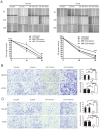The tumor suppressor role of miR-124 in osteosarcoma
- PMID: 24971902
- PMCID: PMC4074038
- DOI: 10.1371/journal.pone.0091566
The tumor suppressor role of miR-124 in osteosarcoma
Retraction in
-
Retraction: The Tumor Suppressor Role of miR-124 in Osteosarcoma.PLoS One. 2019 Mar 13;14(3):e0214018. doi: 10.1371/journal.pone.0214018. eCollection 2019. PLoS One. 2019. PMID: 30865727 Free PMC article. No abstract available.
Abstract
MicroRNAs have crucial roles in development and progression of human cancers, including osteosarcoma. Recent studies have shown that miR-124 was down-regulated in many cancers; however, the role of miR-124 in osteosarcoma development is unknown. In this study, we demonstrate that expression of miR-124 is significantly downregulated in osteosarcoma tissues and cell lines, compared to the adjacent tissues. The expression of miR-124 in the metastases osteosarcoma tissues was lower than that in non- metastases tissues. We identified and confirmed Rac1 as a novel, direct target of miR-124 using prediction algorithms and luciferase reporter gene assays. Overexpression of miR-124 suppressed Rac1 protein expression and attenuated cell proliferation, migration, and invasion and induced apoptosis in MG-63 and U2OS in vitro. Moreover, overexpression of Rac1 in miR-124-transfected osteosarcoma cells effectively rescued the inhibition of cell invasion caused by miR-124. Therefore, our results demonstrate that miR-124 is a tumor suppressor miRNA and suggest that this miRNA could be a potential target for the treatment of osteosarcoma in future.
Conflict of interest statement
Figures





Similar articles
-
MicroRNA-224 promotes the sensitivity of osteosarcoma cells to cisplatin by targeting Rac1.J Cell Mol Med. 2016 Sep;20(9):1611-9. doi: 10.1111/jcmm.12852. Epub 2016 May 25. J Cell Mol Med. 2016. Retraction in: J Cell Mol Med. 2019 Aug;23(8):5832. doi: 10.1111/jcmm.14431. PMID: 27222381 Free PMC article. Retracted.
-
miRNA-646 suppresses osteosarcoma cell metastasis by downregulating fibroblast growth factor 2 (FGF2).Tumour Biol. 2015 Mar;36(3):2127-34. doi: 10.1007/s13277-014-2822-z. Epub 2014 Nov 18. Tumour Biol. 2015. PMID: 25403884
-
Up-regulation of microRNA-491-5p suppresses cell proliferation and promotes apoptosis by targeting FOXP4 in human osteosarcoma.Cell Prolif. 2017 Feb;50(1):e12308. doi: 10.1111/cpr.12308. Epub 2016 Oct 5. Cell Prolif. 2017. PMID: 27704627 Free PMC article.
-
MiR-142 acts as a tumor suppressor in osteosarcoma cell lines by targeting Rac1.Oncol Rep. 2015 Mar;33(3):1291-9. doi: 10.3892/or.2014.3687. Epub 2014 Dec 22. Oncol Rep. 2015. PMID: 25530132
-
MiR-133b is down-regulated in human osteosarcoma and inhibits osteosarcoma cells proliferation, migration and invasion, and promotes apoptosis.PLoS One. 2013 Dec 31;8(12):e83571. doi: 10.1371/journal.pone.0083571. eCollection 2013. PLoS One. 2013. PMID: 24391788 Free PMC article.
Cited by
-
miR-18a-5p promotes cell invasion and migration of osteosarcoma by directly targeting IRF2.Oncol Lett. 2018 Sep;16(3):3150-3156. doi: 10.3892/ol.2018.9032. Epub 2018 Jun 27. Oncol Lett. 2018. PMID: 30127908 Free PMC article.
-
MicroRNA-224 promotes the sensitivity of osteosarcoma cells to cisplatin by targeting Rac1.J Cell Mol Med. 2016 Sep;20(9):1611-9. doi: 10.1111/jcmm.12852. Epub 2016 May 25. J Cell Mol Med. 2016. Retraction in: J Cell Mol Med. 2019 Aug;23(8):5832. doi: 10.1111/jcmm.14431. PMID: 27222381 Free PMC article. Retracted.
-
Bone Microenvironment and Osteosarcoma Metastasis.Int J Mol Sci. 2020 Sep 23;21(19):6985. doi: 10.3390/ijms21196985. Int J Mol Sci. 2020. PMID: 32977425 Free PMC article. Review.
-
A New Paradigm to Mitigate Osteosarcoma by Regulation of MicroRNAs and Suppression of the NF-κB Signaling Cascade.Dev Reprod. 2014 Dec;18(4):197-212. doi: 10.12717/devrep.2014.18.4.197. Dev Reprod. 2014. PMID: 25949190 Free PMC article.
-
Identification of biomarkers associated with the recurrence of osteosarcoma using ceRNA regulatory network analysis.Int J Mol Med. 2019 Apr;43(4):1723-1733. doi: 10.3892/ijmm.2019.4108. Epub 2019 Feb 25. Int J Mol Med. 2019. PMID: 30816442 Free PMC article.
References
-
- Yang J, Zhang W (2013) New molecular insights into osteosarcoma targeted therapy. Curr Opin Oncol 25: 398–406. - PubMed
-
- Ottaviani G, Jaffe N (2009) The epidemiology of osteosarcoma. Cancer Treat Res 152: 3–13. - PubMed
-
- Gougelet A, Pissaloux D, Besse A, Perez J, Duc A, et al. (2011) Micro-RNA profiles in osteosarcoma as a predictive tool for ifosfamide response. Int J Cancer 129: 680–690. - PubMed
Publication types
MeSH terms
Substances
LinkOut - more resources
Full Text Sources
Other Literature Sources
Research Materials

